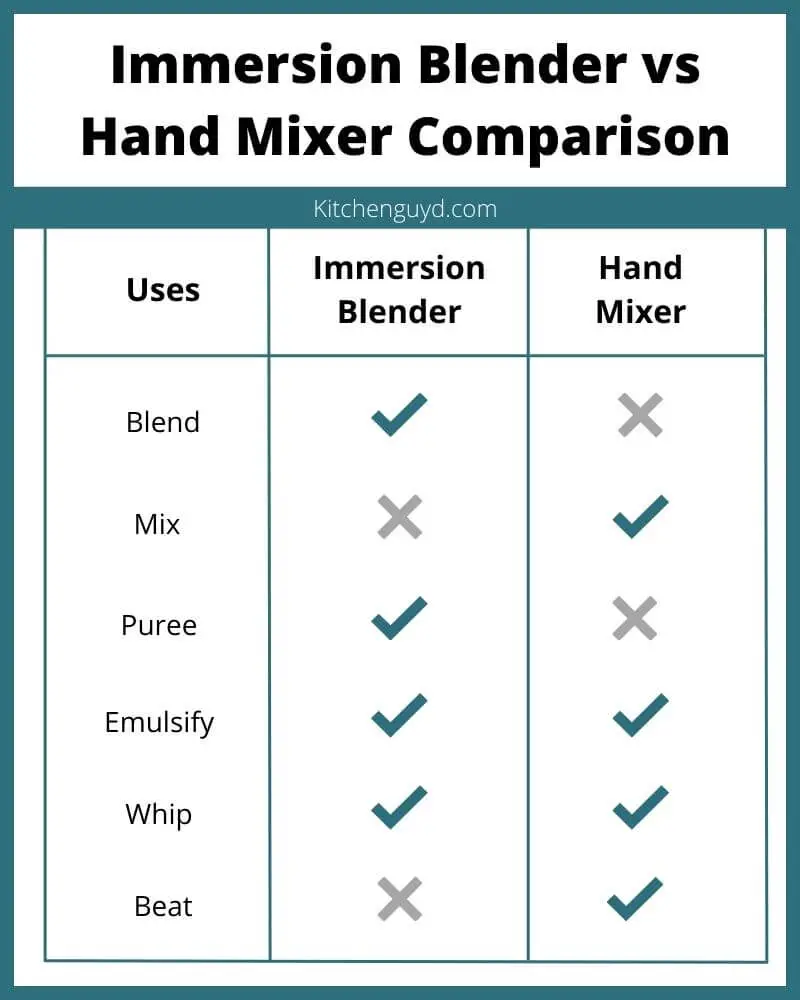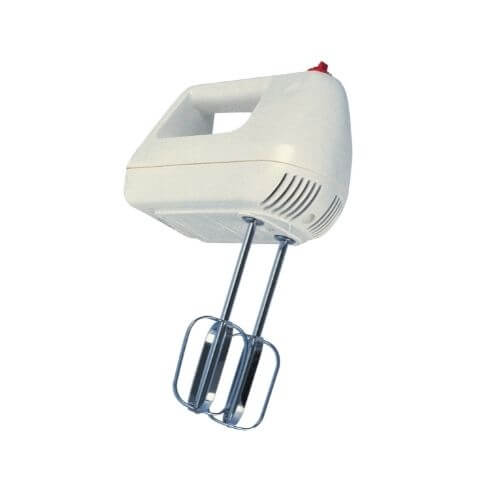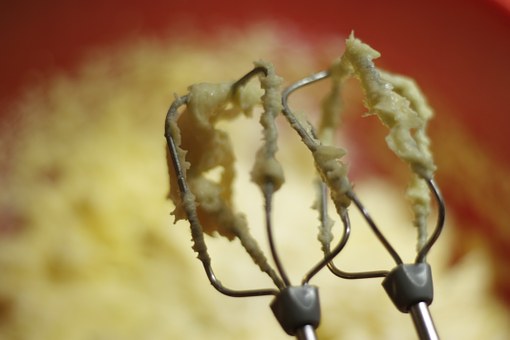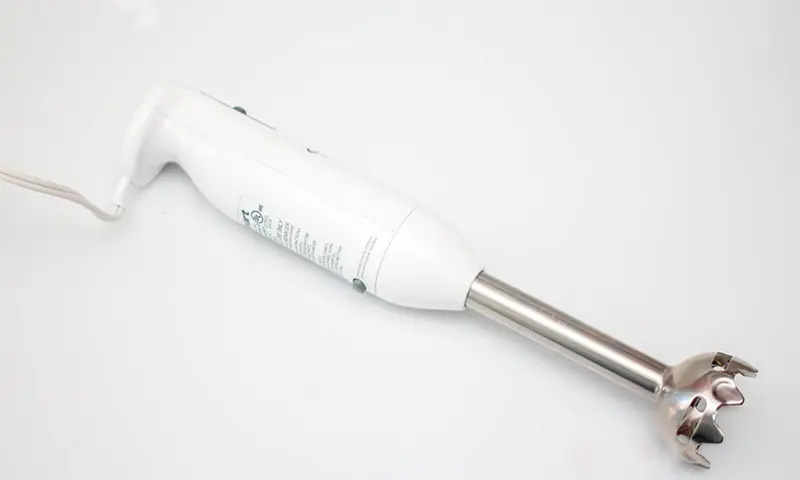Trying to determine the differences between an immersion blender vs hand mixer is common. In this article we’ll lay out the differences and the best uses for each option.
People often mistake an immersion blender for a hand mixer and vice versa because they resemble each other a lot.
However, it is important that you understand the difference between the two so that you don’t end up with the wrong appliance and ruin a recipe.
In this article, we will cover both of these tools and help you differentiate them so that you can choose the correct kitchen equipment for yourself.
Immersion blender vs hand mixer: A Quick Overview
Before we dive into anything too far, I want to share a shortcut to remember the difference between the two appliances.
- Use an immersion blender when you need to blend something.
- Use a hand mixer when you need to mix something.
In other words, if a recipe calls for something to be blended, you will generally be looking to create some sort of puree or emulsion. Whereas, mixing is less aggressive and is meant to combine ingredients more delicately.
Below, we’ll dive deeper and provide some examples.

What is an Immersion Blender?
An immersion blender (a.k.a., hand blender or stick blender) is a small handheld blender that is often used for smoothies and soups. It is basically a stick that is equipped with blender blades at the end and is extremely simple and easy to use.

What’s The Difference Between an Immersion Blender and a Regular Blender?
Immersion blenders differ from a standard blenders in one major way. If you’re using a regular blender for a recipe, you would pour the liquid and other ingredients into the blender in order to mix it well. In other words, the regular blender requires you to transfer the ingredients from one place into the blender directly. However, in case of an immersion blender, you can blend the ingredients directly in a pot or other container.
When making dishes like soups that require blending, many prefer to use immersion blending because it is more convenient and requires less cleanup than washing an entire blender.
How To Use an Immersion Blender
Using an immersion blender is easy once you get the hang of it. Here are the steps:
- Ensure the blending stick attachment is securely placed on the handle.
- Plug in the appliance.
- Insert the blade side into the pot or container your are blending in.
- Ensure the blade is completely immersed in the liquid to reduce splashing.
- Turn the blender to the lowest power setting and then press the button to start blending.
- If needed, increase the power to blend more rapidly.
Once you start using immersion blenders, you’ll start to pick up on techniques that can help. For example, if you are making a butternut squash soup and want to puree the liquid and vegetables, you can start by placing the base of the stick blender flat against the pot. If you notice after a minute or so that some chunks are not blending, you can lift an edge of the blade to get better blending circulation within the pot. And you can also experiment with using the immersion blender one one side of the pot or the other. This helps ensure thorough blending.
Common Uses For an Immersion Blender
Immersion blenders are commonly used for purees. They can also be used for chopping, whipping, emulsifying and even grinding. By far, the most common application of an immersion blender is for purees.
Let’s get specific. Using an immersion blender might be helpful for making foods like the following:
- Pureed soups
- Pesto
- Jam
- Tomato sauce
- Smoothies
- Milkshakes
- Beating eggs
- Whipping cream
- Mixing salad dressing
- Baby food
- Grinding spices and nuts
The list above is by no means comprehensive. But you can start to see that the immersion blender is a versatile tool that can really be a powerhouse in the kitchen.
Immersion blenders are particularly useful when you have to blend a large amount of pureed soup or other liquids that cannot fit inside a normal blender container. In this case, you might have to blend in multiple batches to get a full pot of soup pureed in a standard blender.
However, with an immersion blender, you just need to pour all your ingredients and liquid in a large container (or keep it in the pot it was cooked in) and then immerse the blender inside it to blend all the components together. Sounds extremely convenient, right?
One thing to keep in mind when purchasing a good immersion blender is that make sure it is powerful enough to blend all kinds of food items. Most hand blenders are inexpensive, so finding a good one for a good price shouldn’t be too difficult.
What is a Hand Mixer?
A hand mixer is used to mix different foods together and is mostly used to whip and beat together ingredients for baking foods like cakes, cookies, etc. Hand mixers are sold in two main types: a manual hand mixer and electric hand mixer.
Manual Hand Mixers
As the name suggests, a manual hand mixer (also known as a whisk) doesn’t come with any motor and will come with a simple design. It has a handle to hold the mixer and the end of the beater which will be used to mix the ingredients together.
An addition type of manual hand mixer you might find is a rotary egg beater. This is a device that utilizes a hand crank to spin the beaters and mix. These are not common anymore but you can still find them sold new, if you’re interested in a more manual approach.

Hand mixers can be tiring to use if you are beating a mixture for a long period of time or if the consistency of the mixture is on the thicker side. But they work great for quick jobs like mixing dry ingredients or throwing together a small amount of batter.
Electric Hand Mixers
On the other hand, an electric hand mixer is more convenient, easy to use and helps save a lot of time. It includes a motor and a gear that are responsible for moving the beaters when the hand mixer is turned on.

You can use different speed settings for mixing different ingredients. Some electric hand mixers also include a few accessories to make the mixing process more versatile and fun. Also, with the help of an electric hand mixer, you get a consistent mixture throughout in a much quicker time.
How To Use an Electric Hand Mixer
Using a hand mixer is convenient but takes a little practice to get the hang of it. Here’s how to use one.
- Get the ingredients together in a mixing bowl.
- Immerse the beaters in the container to mix your ingredients.
- Turn on your electric hand mixer by picking the speed (Pro Tip: start on the lowest setting so that the ingredients don’t fly all over.)
- Keep moving the hand mixer slowly so that the beaters and the motor can mix the ingredients together. You don’t have to exert any manual force here, just let the mixer do it’s job to the consistency of your liking.
Common Uses For a Hand Mixer
Hand mixers are very commonly used for baking. Think cakes and frostings. But there are so many more ways to use a hand mixer than baking. Below are some ideas to use this appliance in your everyday cooking:
- Mashed Potatoes
- Cake batter
- Cookie dough
- Frosting
- Egg whites (for stiffening)
- Shredding cooked chicken
- Mixing ingredients for meatballs
- Guacamole
- Whipped cream
The main thing to keep in mind is a hand mixer is good at incorporating ingredients together. So if you grow tired of mixing ingredients manually, think about using an electric hand mixer to get the job done instead.
Immersion Blender vs Hand Mixer
So, now that we understand the use of an immersion blender and a hand mixer, it’s time to highlight the differences between the two.
After learning more about both of them you must have noticed a few obvious differences in their design and their usage but after reading this section, you will be certain about those differences and will know which is the right tool for a particular job.
What Are The Differences?
As mentioned before, a blender is primarily used to turn foods into puree/liquid and is most commonly used if you want to make shakes, smoothies, frozen drinks, soups, etc. You can use a blender to make fresh sauces and purees.
On the other hand, a mixer is mostly used to combining different ingredients and might not necessarily turn them into puree/liquid. A mixer is more subtle than a blender. So, you can use your mixer to prepare batter or dough but you can’t use it to make smoothies or shakes very easily.
You can hold both the immersion blenders and hand mixers in your hand which makes them easy and convenient to use. It also makes them less powerful since they don’t come with a heavy motor. But they offer more versatility to you.
Here’s a major functional difference. An immersion blender has blades attached to it while a hand mixer has beaters attached to it. The blade is good at blending. The beaters are good at combining.

One of the best things about an immersion blender is that you can use it to smooth out your chunky soup without having to first transfer your hot soup from your cooking pot to your blender container. With the help of an immersion blender, you can also prepare other recipes like salsas, sauces, etc.
While a hand mixer can whisk your eggs together, it cannot easily help you in preparing the bread dough. You would likely need a stand mixer with the right attachments to help out in making bread dough. But you can usually use your hand mixer to prepare food like waffles, pancake batter, cookies, whipped cream, and so on.
What Are the Similarities?
As we have clearly established by now, a hand mixer and an immersion blender are two different kitchen tools but there are a few kitchen tasks that can be performed by an immersion blender or a hand mixer.
You can easily beat eggs for making egg dishes using both the immersion blender and the hand mixer. Although an immersion blender makes the eggs fluffier, don’t purchase an immersion blender just to beat your eggs.
You can also whip cream with both an immersion blender and hand mixer. While a hand mixer will do a better job, there is no reason to purchase it if you already own an immersion blender.
Frequently Asked Questions
Let’s take a look at some FAQs. Because let’s face it, sometimes you just want the answers fast!
Can You Make Smoothies With an Immersion Blender?
Yes, with a caveat. Making a single or double serving of smoothies is very possible using an immersion blender. And if you don’t have a large, regular blender to use, then an immersion blender will work just fine.
Here’s the caveat – if you are looking to make a large batch of smoothies, using a an immersion blender could be time consuming. Due to the fact that smoothies generally contain a large number of frozen fruits, you might find yourself blending for quite some time. Whereas, with a regular blender, making a large batch of smoothies is quick and easy. Bottom line, the immersion blender will generally do the trick!
Can I Use a Hand Mixer Instead of an Immersion Blender?
For the preparation of some foods, hand mixers are an acceptable substitute. However, using a blender is preferable and even necessary for certain items. For example, a mixer will not work well if you are looking to make a frozen smoothie, grind some spices, or puree foods with a tough consistency. But for items that are soft or do not need to be pureed, a hand mixer will work well.
Can you Puree With a Hand Mixer?
It depends on what you are mixing. Something frozen and tough will be very difficult to puree with a mixer. But if you are making something where all of the ingredients are very soft, then you should be able to get pretty close to a puree. Just don’t rely on the mixer to produce the same smooth results that can be achieved with an immersion blender.
Can I Use a Hand Mixer Instead of an Immersion Blender For Soup?
Using a hand mixer for soup can be a substitute for an immersion blender. But you will likely still end up with small chunks of the food you are mixing. Making food smooth is what immersion blenders do well. If you have a soup with very soft ingredients, such as squash, then a mixer should do the job.
